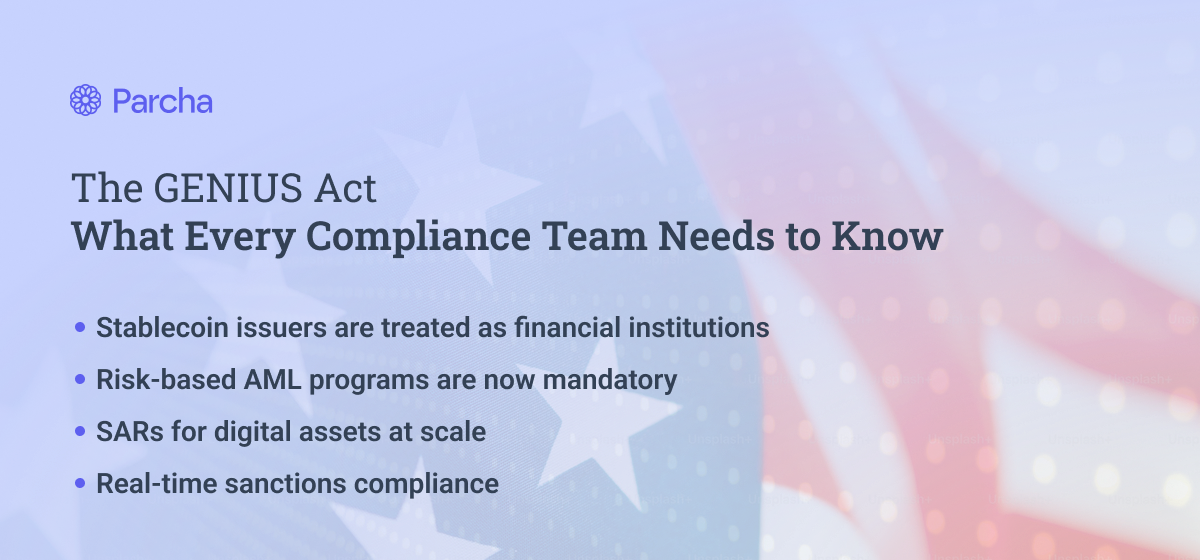The GENIUS Act: What Every Compliance Team Needs to Know
Last week's GENIUS Act signing wasn't just about stablecoins – it was about fundamentally reshaping how we think about AML compliance in the digital asset space.

Last week's GENIUS Act signing wasn't just about stablecoins – it was about fundamentally reshaping how we think about AML compliance in the digital asset space.¹
Here's what most people missed: This isn't just regulatory clarity. This is the most comprehensive expansion of AML requirements we've seen in years, and it's going to force every compliance team to rethink their approach.
The AML Requirements For Issuers
The Act treats stablecoin issuers as "financial institutions" under the Bank Secrecy Act.² That means they're subject to the full spectrum of AML obligations that traditional banks face, but with some digital asset-specific twists that are fascinating.
But first, let's be crystal clear about who we're talking about. The GENIUS Act defines a "stablecoin issuer" very specifically – these are companies that create and mint stablecoins backed 1:1 by reserves. Think Circle (USDC) or Tether. A company that provides cross-border payments using existing stablecoins is not considered an issuer – they're what the Act calls a "digital asset service provider." Different category, different rules.
Here's what this actually means for AML compliance:
🔍 Risk-Based AML Programs Are Now Mandatory
Every permitted stablecoin issuer must implement comprehensive, risk-based AML programs including customer identification, due diligence procedures, and ongoing monitoring. But here's the kicker – FinCEN has to tailor these requirements to the size and complexity of each issuer. This isn't one-size-fits-all compliance.
📊 Suspicious Activity Reporting Gets Digital
Stablecoin issuers must file SARs with FinCEN just like traditional financial institutions. Think about that for a moment – we're now going to have suspicious activity reports for digital asset transactions at unprecedented scale. The data intelligence possibilities are incredible.
⚡ Real-Time Sanctions Compliance
This is where it gets really interesting. Issuers must maintain the technological capability to freeze and burn wallets to comply with lawful orders.³ Your AML monitoring can't just flag suspicious transactions – it needs to be connected to systems that can instantly block assets.
The Foreign Issuer Angle Changes Everything
The Act creates a fascinating compliance dynamic for foreign issuers. They must meet the same AML standards as US companies if they want to issue stablecoins to US holders. The Treasury Secretary can publicly designate non-compliant foreign issuers and impose civil penalties up to $1 million per day.⁴
This creates a global compliance race – foreign stablecoin issuers now have to build US-grade AML programs or lose access to the world's largest market.
What This Means for Your Compliance Program
The GENIUS Act creates different compliance obligations depending on what your company does:
If you're a stablecoin issuer (creating and minting stablecoins): You're now a "financial institution" under BSA with full AML program requirements, real-time compliance capabilities, and annual certifications.
If you're a digital asset service provider (facilitating transactions, providing custody, or offering cross-border payments using existing stablecoins): You face restrictions on which stablecoins you can work with – only those issued by approved "permitted payment stablecoin issuers."
If you're a traditional financial institution considering stablecoin services: The regulatory clarity may make it easier to expand into custody and tokenization services, but you'll need to ensure any stablecoin partners are properly licensed.
The $10 billion threshold creates two regulatory worlds – state-level for smaller issuers, federal oversight for larger ones.⁵ And here's what I find most compelling: The Act requires annual certifications of AML compliance for issuers. That's a higher reporting standard than what banks currently face, with criminal penalties for false certifications.⁶
Here's what you need to do right now:
Immediate Actions (Next 30 Days):
- Audit your current AML program against the new BSA requirements for stablecoin exposure
- Map your stablecoin touchpoints – Do you custody, facilitate, or interact with stablecoin transactions?
- Review your technology stack – Can your systems support real-time asset freezing if required?
- Assess foreign counterparty risk – Are you working with any foreign stablecoin issuers who might not meet US standards?
Medium-Term Planning (3-6 Months):
- Upgrade monitoring systems to handle digital asset transaction patterns and risk indicators
- Train your compliance team on stablecoin-specific AML requirements and red flags
- Update policies and procedures to include digital asset compliance protocols
- Establish relationships with compliant stablecoin issuers if you plan to integrate digital assets
Strategic Preparation (6-12 Months):
- Build or buy compliance technology that bridges traditional and digital asset monitoring
- Develop annual certification processes that meet the Act's rigorous standards
- Create competitive advantages by making compliance seamless rather than burdensome
- Prepare for examination readiness under the new regulatory framework
The Broader Implication
This isn't just about stablecoins. This is about establishing the framework for how digital assets integrate with traditional AML compliance. The GENIUS Act is essentially saying: "If you want to operate in digital finance, you need to meet the same AML standards as traditional finance – plus some additional requirements."
The companies that figure out how to make this compliance seamless and scalable are going to have a massive competitive advantage. The ones that treat this as just another regulatory burden? They're going to struggle.
At Parcha, we're already seeing customers ask how they can adapt their existing AML programs to handle these new requirements. The opportunity is enormous for compliance tech that can bridge traditional and digital asset monitoring.
The Bottom Line
The GENIUS Act just made AML compliance for digital assets more rigorous than it's ever been. But it also created clarity that's going to accelerate innovation in the compliance space.
Are you ready to rethink your AML program for the post-GENIUS world?
Curious how these new AML requirements might impact your compliance program? I'd love to discuss what we're seeing in the market – Schedule a call today.
Key Takeaways
- Financial Institution Status: Stablecoin issuers are now treated as financial institutions under the Bank Secrecy Act
- Comprehensive AML Requirements: Risk-based programs, customer due diligence, and ongoing monitoring are mandatory
- Real-Time Compliance: Technical capability for instant asset freezing is required
- Global Standards: Foreign issuers must meet US AML standards or face significant penalties
- Annual Certifications: Higher reporting standards than traditional banks with criminal penalties for false filings
- Compliance Technology Opportunity: Massive market for solutions that bridge traditional and digital asset monitoring
About the Author
AJ Asver is the CEO of Parcha, a company that enables banks and fintechs to onboard more customers faster with stronger compliance using AI to accelerate KYC/B reviews, document verification, and AML screening. He hosts "The Hitchhiker's Guide to AI" podcast and regularly writes about the intersection of AI, compliance, and financial services.
Contact:
- LinkedIn: https://linkedin.com/in/ajasver
- Email: aj@parcha.com
- Learn more about Parcha: https://parcha.com
- Schedule a demo: https://parcha.com/demo
Citations
- President Donald Trump signed the GENIUS Act into law on July 18, 2025. Mayer Brown, "GENIUS Act Signed into Law US Enacts Federal Stablecoin Legislation," July 2025. Available at: https://www.mayerbrown.com/en/insights/publications/2025/07/genius-act-signed-into-law-us-enacts-federal-stablecoin-legislation
- Section 4(a)(5)(A) of the GENIUS Act designates payment stablecoin issuers as "financial institutions" under the Bank Secrecy Act. Gibson Dunn, "The GENIUS Act: A New Era of Stablecoin Regulation," July 2025. Available at: https://www.gibsondunn.com/the-genius-act-a-new-era-of-stablecoin-regulation/
- U.S. Senate Banking Committee, "FACT SHEET: The GENIUS Act Bolsters National Security," 2025. The Act mandates issuers maintain technical capacity to freeze and burn wallets for lawful order compliance. Available at: https://www.banking.senate.gov/newsroom/majority/fact-sheet-the-genius-act-bolsters-national-security
- Section 8 of the GENIUS Act authorizes Treasury to impose civil penalties up to $1 million per day on non-compliant foreign issuers. WilmerHale, "What the GENIUS Act Means for Payment Stablecoin Issuers, Banks, and Custodians," July 2025. Available at: https://www.wilmerhale.com/en/insights/client-alerts/20250718-what-the-genius-act-means-for-payment-stablecoin-issuers-banks-and-custodians
- S.394 - 119th Congress (2025-2026): GENIUS Act of 2025, Section 7. Congress.gov, available at: https://www.congress.gov/bill/119th-congress/senate-bill/394/text
- The Act provides for criminal penalties for false AML compliance certifications. Gibson Dunn, "The GENIUS Act: A New Era of Stablecoin Regulation," July 2025. Available at: https://www.gibsondunn.com/the-genius-act-a-new-era-of-stablecoin-regulation/

